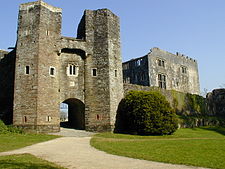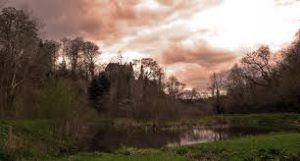“Berry Pomeroy Castle is reputed to be one of the most haunted castles in Britain.” English Heritage guidebook.
“There’s something pretty potent here. There’s a very evil force and if you ever encounter it at Berry Pomeroy, get out quick”
The Romantic Movement of the first half of the nineteenth century glorified the past and the natural world. It was partly a reaction to the new factories and cities of the Industrial Revolution and can be seen most strongly in the visual arts, music, and literature. Romanticism emphasized the individual and the imaginative and was fascinated by folklore, our national origins and particularly the medieval era.
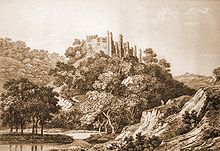
As part of this emerging Romantic sensibility, in 1782 William Gilpin introduced the idea of the ‘Picturesque’ to the public. His book instructed England’s leisured travellers to examine, “the face of a country by the rules of picturesque beauty”. He recommended visiting Gothic and Celtic places, which coincided nicely with the growth of Torquay as a town. Our educated and affluent visitors consequently searched out the remote and the mysterious. If they couldn’t find it, they invented it.
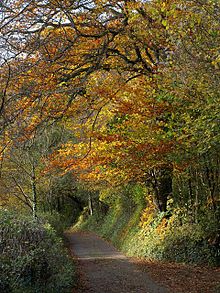
For the Torquay tourist nothing was more romantic than the Gothic Berry Pomeroy Castle and the winding lanes surrounding the ruins. This long-derelict Tudor mansion within the walls of an earlier castle had been abandoned in the late 17th century when the fourth baronet moved to Wiltshire. It was ideal, and also within an easy day’s trip from the growing tourist towns of the Bay. By 1848 Alfred Lord Tennyson (pictured below) was writing about the castle’s mystical qualities.

We know that Torquay’s inventive and competitive tourist guides tended to import, embroider and invent stories for their paying customers. Accordingly, Berry Pomeroy acquired the reputation for ghostly phenomena and all the other expected trappings of a ruined castle. These included strange lights, voices, cold spots, freak winds, strange shadows, a wishing tree and secret passages.
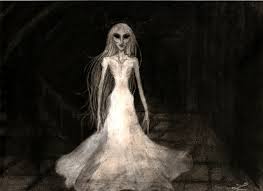
While stories of hauntings have circulated locally for hundreds of years, they didn’t become widely known until they were publicized in the late 19th century in the memoirs of the physician, Sir Walter Farquhar. Sir Walter related how he was summoned to the castle to attend to the ill wife of the castle’s steward. While he waited, a beautiful young lady in white entered. She was in distress and was wringing her hands. She walked across the room, mounted a staircase, then looked directly at Walter and vanished. The following day, Walter again attended the sick woman and remarked on the strange appearance of the woman in white. The steward became distressed, and explained that Walter had seen the family’s death omen. A few hours after seeing the ghost of the lady in white, the steward’s wife died.
So, who was the White Lady? According to family legend, the ghost is that of a daughter of a former owner. She was a cruel woman and, as punishment for her sins, she is doomed to haunt the castle. The ghost also allegedly appears outside the castle, luring people into unsafe places where they might have accidents.
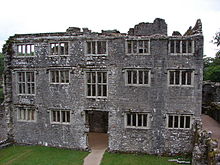
Berry Pomeroy isn’t alone in having a resident wandering female ghost – there’s another similar spirit at Torre Abbey, though that apparition is less malevolent. Indeed, such supernatural White Ladies can be found throughout the world, and in many cultures, and are usually associated with the tragic loss of a loved one.
On the other hand, these do differ in character. In Holland and Germany they were said to be healers and gentle spirits – German legend has them appearing at noon, beautiful in the bright sunlight while the Dutch have these spectres haunting graveyards at night. In Ireland and Britain, however, they can be more sinister as women in white are said to foretell death as at Berry Pomeroy. Yūrei, in Japan, are vengeful spirits attached to certain objects or places and which attack passers-by.

Another candidate for the role of White Lady is the spirit of Margaret Pomeroy, who was imprisoned by her sister Eleanor. Eleanor was jealous of both Margaret’s beauty and her love for the man Eleanor had designs upon. Margaret starved in the dungeons and, on moonlit nights, rises from St Margaret’s Tower and can be seen gliding along Ramparts Walk where she has been seen beckoning to witnesses as recently as 1987 – or still is if we can find a more up-to-date encounter.
Then there’s the Blue Lady – another Pomeroy daughter – who is said to beckon for help from passers-by, luring them to her tower. If they go to her, they fall to their death – you would think that English Heritage would put up some kind of warning sign. This second female apparition is said to have been the daughter of a Norman lord and wanders the dungeons mourning the loss of her baby. According to one particularly unpleasant story, she was raped by her father who then strangled the resulting child in one of the upper rooms. In another version it is she who strangles the child, haunting the castle in anguish. In both versions the baby’s ghostly cries are said to still echo through the ruins. Incidentally, in Mexico the La Llorona legend has it that women in white drowned their children, and lurk by water to drown more.
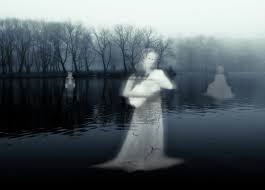
Another popular tradition relates to the heroic fate of two Pomeroy brothers who were besieged at the castle. To save face from imminent defeat, they dressed in full armour, mounted their horses, and rode off the top of the castle ramparts. The area was subsequently known as the Pomeroy’s Leap, and is associated with screams and (unintentionally funny Pythonesque) dull thuds. However, none of these stories have any historical evidence to back them up. Indeed, the “being locked in a castle dungeon to starve and come back as a ghost” legend crops up in many places across Europe.
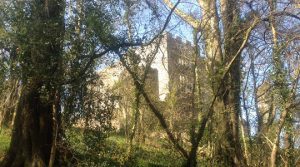
Continuing the Romantic tradition, established way back in the seventeenth century, we have this terrific 1993 American clip. It describes how fortunate we all are to live in the shadow of, “the crumbling walls of this once great fortress perched above the desolate moors that blanket southern England.” It certainly is a privilege to reside in “a land of ancient superstition, defiled tombs, and long abandoned graveyards.”


